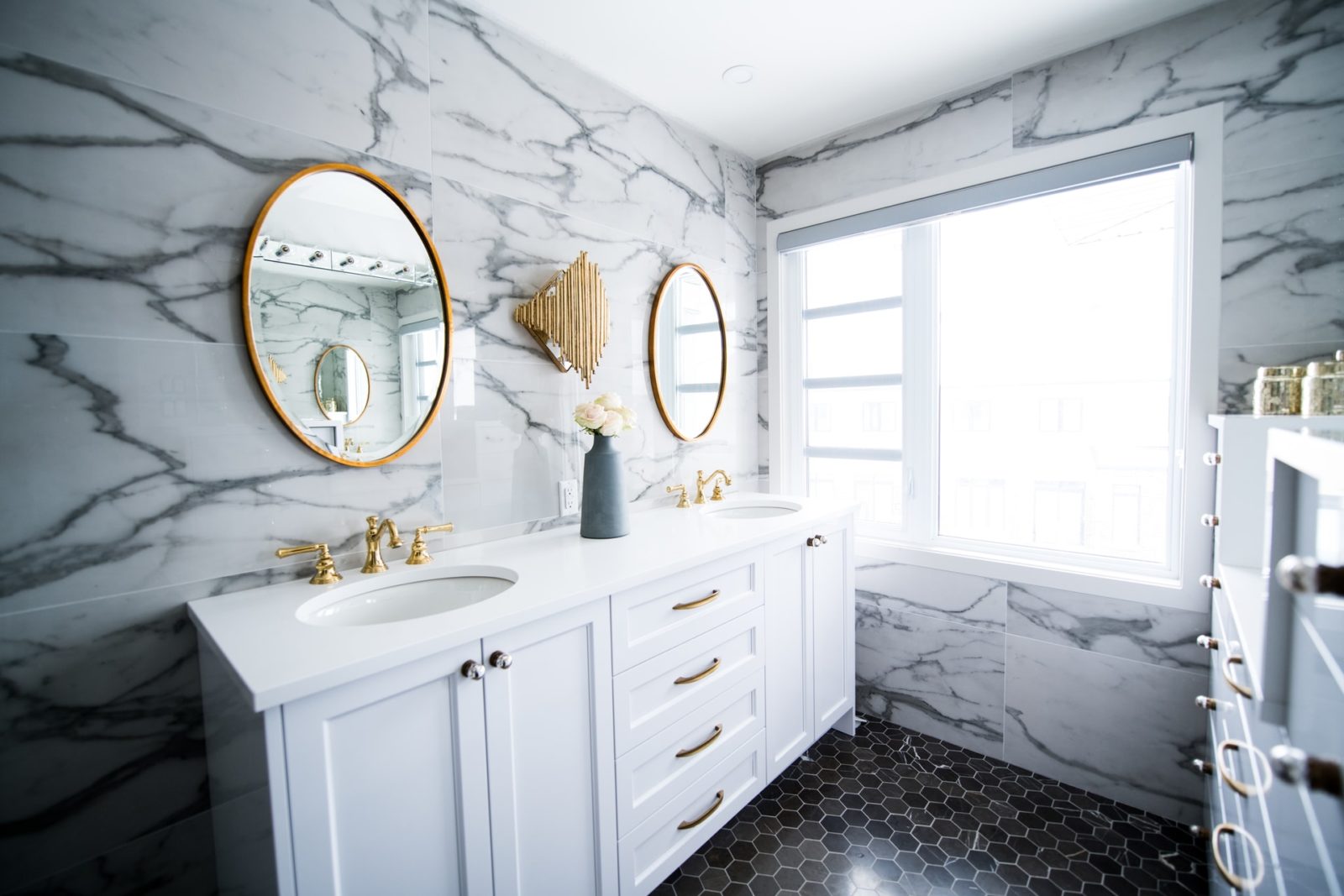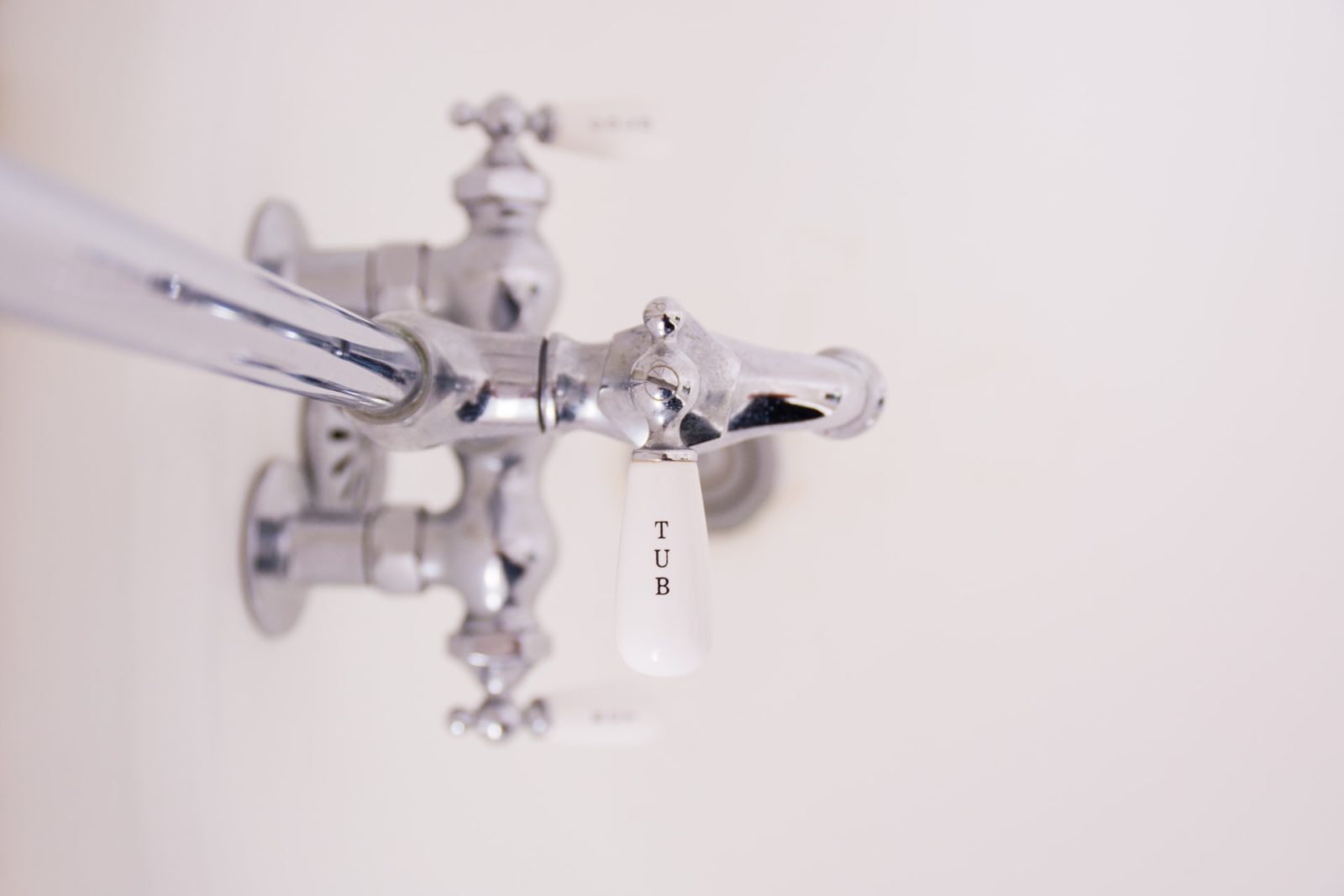Interested in knobbed faucets? Check out our last guide on bathroom faucet design to get all of the beginning points.
Double-Handled Faucets
The handle design is much more common. Let’s see why.
Pros
The first thing to love about double-handled faucets is the ease of use. There’s no need to get a good grip on it to turn it off or on.
Because of the ease of turning them off or on, double-handled faucets are also great for hygiene. You can touch it minimally, bump it off with your elbow, or turn it off with a paper towel.
Additionally, cleaning them is much easier. Wiping them down is simply a matter of wrapping a paper towel or cloth with some cleaner on it around the handle and pulling gently.
Plus, because sink handles are typically only touched on the part extending from the base, water doesn’t drip onto the base as much. That means they don’t grow mold as frequently as knobs do. This is especially true if the knobs are attached directly to the sink, If on a raised platform that’s part of the faucet, there are extra corners where water accumulation can be a problem. Therefore, we recommend handles that are installed right on the sink.
The complete opposite of knobs, double-handled faucets are very child friendly. This can be great for when they’ve been taught how to use the sink and know to be careful with hot water or to stick to the cold water handle only.
Faucet handles are also easy to tighten, should they come a bit loose. Because the part of the handle that people touch is a screw-on addition to the actual mechanism, all you have to do to tighten it is turn the handle clockwise. This is a much simpler fix than with knobs.
Cons
Double-handled faucets, much like knobs, have three separate places where they can break. Shower mixer valves repair can sometimes be difficult. There are also a lot of steps to disassembly. Those include unscrewing the handle, removing the decorative cap, which usually has a tiny screw on the side, and then removing and replacing any hardware beneath that.
And, also the opposite of knobs, the child friendly nature of handles makes them easy for small children to mess with before they know how to use the sink properly. At the least, this can make a mess. At worst, they can leave the sink running and flood the bathroom. If your small children are prone to messing with the sink, it’s best to get a childproof mechanism for the sink knobs to prevent problems.
Single-Handled Faucets
Single-handled faucets, like those that are common in the kitchen, are just as good in bathrooms. Here’s what makes them a great bathroom faucet design and where they have drawbacks.
Pros
The first great thing about single-handled faucets is their ease of use. Just by virtue of being a single handle, they’re twice as easy as double-handled faucets to turn on and off.
Likewise, they’re also better for touch hygiene. While turning them on with an elbow isn’t as easy as double-handled faucets, due to the need to lift, turning them off when your hands are wet and freshly cleaned is as simple as pressing down with your elbow.
This bathroom faucet design is also great for keeping clean. There are many designs for single-handled faucet handles, but the best for hygiene are those that are sleek and either straight or curved. Rounded handles that are reminiscent of those outdated knobs pose the same hygiene problems. However, their straight counterparts are very simple to wipe down and don’t have all of those ridges for mold and bacteria growth.
Having a single handle can make getting warm water easier. While double-handled faucets require twice as much contact and a lot more effort to get the correct temperature, single handled faucets can be moved to one place every time you want a certain temperature. This motion can become second nature. It’s very convenient.
Cons
Unlike double-handled faucets, single-handled ones require you to put your wet hands over the handle mechanism. This means a lot of water on the mechanism. This can lead to molding around the faucet as well as mineral buildup in the moving parts. That can be a huge problem if you have hard water. Not to mention the increase in water spots on the spout below, which can be frustrating for people who like their hardware looking shiny and clean.
The downside of the temperature being chosen from one handle is that in for some people or in some older buildings, getting the temperature to be warm, rather than super hot or super cold, can be tricky.
Easy Faucet Repair
If you’re looking into replacing your faucet because your old one has sprung a leak, it might be worth fixing. Save yourself some money and give us a call at POM Plumbing. We can repair your sink faucet in no time at all, no matter what bathroom faucet design you have. However, if you’re replacing your faucet for aesthetic or age purposes, we hope our little guide helped you with your decision! Give us a call if you have any further questions and we’ll be happy to help.

